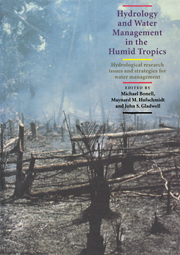 Hydrology and Water Management in the Humid Tropics
Hydrology and Water Management in the Humid Tropics Book contents
- Frontmatter
- Contents
- List of Authors
- Foreword by Federico Mayor, Director-General, UNESCO
- Preface
- Cartographic Credit
- Acknowledgements
- SECTION I INTRODUCTION
- SECTION II HUMID TROPICS SETTING
- SECTION III REGIONAL HYDROLOGY
- SECTION IV PHYSICAL PROCESSES
- SECTION V PHYSICAL PROCESSES – HUMAN USES: THE INTERFACE
- 17 Challenges in Agriculture and Forest Hydrology in the Humid Tropics
- 18 The Impact of Land-Use Change on Water Resources in the Tropics: An Australian View of the Scientific Issues
- 19 Urban Water Management Problems in the Humid Tropics: Some Technical and Non-Technical Considerations
- 20 The Management of Water Resources, Development and Human Health in the Humid Tropics
- 21 Water Supply and Health in the Humid Tropics with Particular Reference to Rural Areas
- SECTION VI MANAGEMENT ISSUES
- SECTION VII APPENDICES
- Place index
18 - The Impact of Land-Use Change on Water Resources in the Tropics: An Australian View of the Scientific Issues
Published online by Cambridge University Press: 23 December 2009
- Frontmatter
- Contents
- List of Authors
- Foreword by Federico Mayor, Director-General, UNESCO
- Preface
- Cartographic Credit
- Acknowledgements
- SECTION I INTRODUCTION
- SECTION II HUMID TROPICS SETTING
- SECTION III REGIONAL HYDROLOGY
- SECTION IV PHYSICAL PROCESSES
- SECTION V PHYSICAL PROCESSES – HUMAN USES: THE INTERFACE
- 17 Challenges in Agriculture and Forest Hydrology in the Humid Tropics
- 18 The Impact of Land-Use Change on Water Resources in the Tropics: An Australian View of the Scientific Issues
- 19 Urban Water Management Problems in the Humid Tropics: Some Technical and Non-Technical Considerations
- 20 The Management of Water Resources, Development and Human Health in the Humid Tropics
- 21 Water Supply and Health in the Humid Tropics with Particular Reference to Rural Areas
- SECTION VI MANAGEMENT ISSUES
- SECTION VII APPENDICES
- Place index
Summary
ABSTRACT
Northern Australia only includes the wet-dry tropical subregion of Chang and Lau's humid tropics; the remainder is within the dry tropics. However, the continent experiences some of the highest short-term rainfalls in the humid tropics which have significant ramifications for the hydrology and requirements for land conservation. This paper describes the limited Australian experience in change in land-use hydrology within the wet-dry tropics, and also devotes some attention to temperate Australian work, e.g., hydrology of eucalypt trees, to evaluate the potential for technology transfer. The account will commence with a brief statement of the four basic balance equations in hydrology and the characteristics which are relevant in the humid tropics and the general nature of Australia's research in these fields.
INTRODUCTION
The colloquium was held in Townsville in Northern Queensland at a latitude of 19°S and so was at the poleward limit of the humid tropics. However, the combination of geomorphology and seasonal wind patterns means that true humid tropic climate reaches within 100 km of Townsville. Significant hydrologic research on both basic hydrology and landscape management in the humid tropics also is based in Townsville.
This paper complements the basic paper on this topic by Lal (this volume) and presents an Australian viewpoint. It was prepared originally at short notice because ill-health seemed likely to preclude any contribution to the colloquium by Rattan Lal. The paper has now been modified to emphasize the nature of Australian research into land-use impacts generally. The limited nature of tropical rain forest and humid tropical hydrology in Australia means that this paper will focus in particular on the possibilities of technology transfer.
- Type
- Chapter
- Information
- Hydrology and Water Management in the Humid TropicsHydrological Research Issues and Strategies for Water Management, pp. 405 - 413Publisher: Cambridge University PressPrint publication year: 1993


